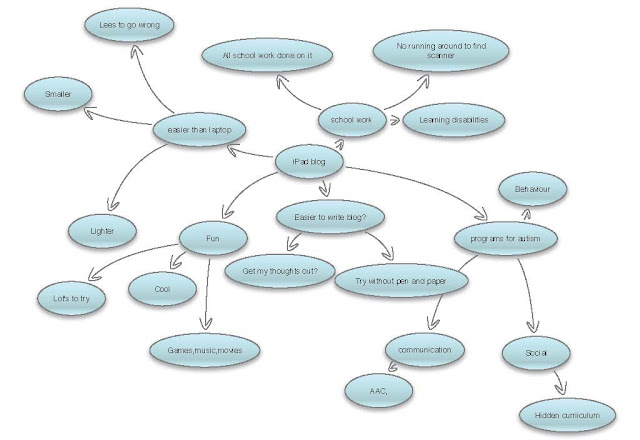I'd never seen an iPad up close and certainly would never
have thought you could do school work on it.
That's what laptops are for!
Everybody at school knows you are in special education when
you drag out your big school laptop and the programs for your school work
regularly have problems.
To complete your work, you have to find the scanner in the
school, scan the work in, come back to class, do your work, then go and print
it out somewhere.
An iPad on the other hand is cool. Who doesn't want
one? It's small, light, and doesn't
usually crash. It's fun. You can use it for games, music, movies, and learning (most
important of course!).
For those of us with autism, especially those who are
non-verbal or have learning disabilities, the iPad is a great thing. There are
programs for communication, social skills, behaviour support, visual supports,
school work and more!
For non-verbal kids, there are apps like Proloquo2go andTalking Tiles. I am only non-verbal at times so I use free text to speech apps
or I use texting. I sometimes use texting in Parent Support Group because I
can't usually speak out in the meeting. I can text my autism consultant who is
leading the group and she will say out loud what I want to say.
The apps for social skills can teach emotions, body
language, how to have a conversation, and social skills for the work place.
There are more apps being made regularly.
There are even apps to help teach the hidden curriculum for
kids and adults. For kids: things like not yelling to another student that he
didn't pull up his zipper or that he has toilet paper stuck to his shoe, instead
saying it to him quietly so he doesn't get embarrassed. For adults: things like if you regularly
accept rides from a friend or coworker, it's nice to help pay for gas.
Apps for behavioural supports include visual timers,
first-then, and even ABA programming.
The thing that really surprised me was that there are apps
which can help with school work. Who knew!
A student can do all of her school work on an iPad.
If they have trouble taking notes from the black board, all
they have to do is take a picture and they have the notes. Lectures can be
recorded on the iPad. Work sheets can be filled in by using the Scanpro app to
scan it into the iPad and then you can open the document in the Notability app.
A text box can be brought up for each blank that needs to be filled in. This app can be used to fill in all
paperwork. The completed work can be sent to the Dropbox app and a link can be
shared with the teacher who can then get on her computer to print it out or
correct it and then send it back to Dropbox.
The Inspiration app can be used to help in essay writing. It
comes with different templates for writing essays, science lab reports, history
papers, and others. You can make your own template as well. The main idea is in
the centre with topics coming off of it and sub topics coming off topics if
needed.
 Once the brainstorming is completed, the template can be sent
to Notability and you can then fill in sentences under the topic headings.
Once the brainstorming is completed, the template can be sent
to Notability and you can then fill in sentences under the topic headings.
After learning about these neat apps, I thought it would be
great for us to get an iPad for our daughter to do her school work on. She used
a laptop previously but it was starting to be discouraged at her first school
and then at the second school she was afraid to bring it out.
She is now in a new school and uses her iPad.
She enjoys using it.
On Friday, she and a classmate even used it in a skit they
did for a health project. She is not afraid to use it in the Community Class
but she hasn't done any integration yet. I hope that when she starts going to some
integration classes she will be so used to working on it that it will not cause
her anxiety to bring it out in front of the big class.
I decided to borrow Micah's iPad to write this blog. It only made sense since it is a blog about
the iPad.
I really struggle to write. Just getting a topic is
difficult and then I have to break that down and write it. Usually my autism consultant
will help choose a topic and then break it down into smaller chunks so that I
can write it. This is one that I chose on my own.
I used Inspiration to break it down into chunks and now I am
using Notability to fill it in.
Usually when I write my blog, I use pen and paper and then
type it into the computer, send it to my autism consultant to edit it, and then
post it after correcting it.
I'm not accustomed to utilizing an iPad. This is the first
time I have tried to write on it.
I think in some ways it was simpler to write especially
using Inspiration to brainstorm but it is difficult not using pen and paper as
I have been for 35 years and this keyboard and screen are a lot smaller than I
am used to.
I will need more practice to really see if it helps my
writing but it has been fun and now I want an iPad of my own! Maybe in the future?
Now I wonder if I can post this to my blog from the iPad or
if I have to do it on the computer?

